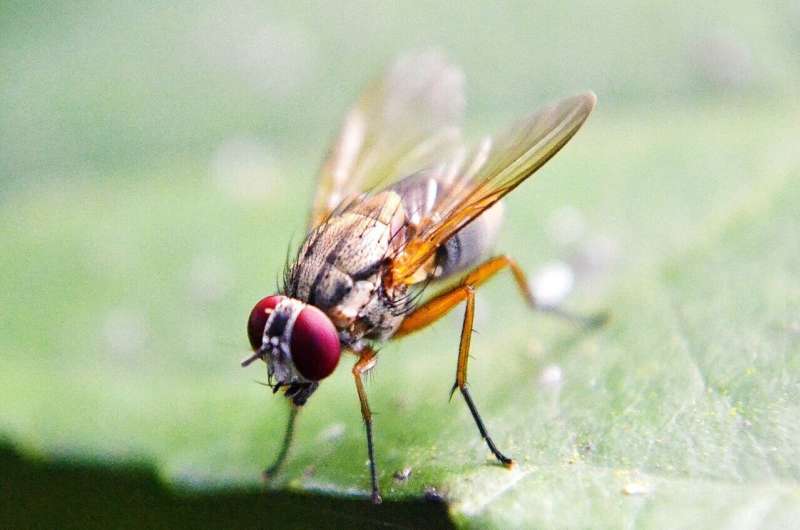Sensation through the legs: What flies do and don't perceive when walking

Stephanie Baum
scientific editor

Robert Egan
associate editor

How do insects perceive mechanical stress? This is a question of interest in many different fields, including comparative morphology, neurobiology and robotics.
A team led by Dr. Brian Saltin of the Bonn Institute of Organismic Biology has developed a computer model to study the fruit fly Drosophila, focusing on the creature's tiny sensory organs for perceiving mechanical stress located near its leg joints. Using this newly developed model, the researchers have been able to study how the position, orientation and material properties of these sensors influence their function. Simulations run have shown how in normal forward walking these sensory organs appear not to be activated solely through the force of footfall.
The findings have now been in the Journal of the Royal Society Interface.
The purpose of the study is to better understand how insects, with their relatively simple nervous system, coordinate their many legs. This is biologically important because insects are one of the largest animal groups.
Also, because the fly's system represents a simple model for neurological processes, this work can yield a better understanding of elementary processes, thereby advancing both neurobiology and robotics as a whole. The study focused on the tiny sensory organs of the fruit fly Drosophila which are located near its leg joints, known as the campaniform sensilla.
The study involved three methods employed in combination: High-speed cameras were used to record the three-dimensional movement of the flies' legs. The team's research partners in the U.S. employed motion methods known as inverse kinematics and inverse dynamics to calculate the relevant force of footfall. As the final piece of the puzzle, electron microscopy was employed to trace the precise internal and external geometry of the sensory organs on a scale of thousandths of a millimeter.
The data obtained through these three methods were integrated in order to build and then run a computer simulation of how the sensory organs undergo deformation when the creatures scurry around on their legs. As a last step, the team compared the stress levels against the stress known from the literature to be necessary to mechanically activate sensory cells by ion influx.
Employing the model, the researchers were able to show that the stress load during normal forward walking does not suffice to activate these small sensory organs located on the creature's thighs. The findings support alternative explanation models of how the sensory organ is activated and functions at this position, such as by local muscle forces. While flies are not as strong as ants, for their size they are still powerful. Insects have many mechanical sensory organs, not all of which need to provide input for each individual behavioral action.
Thus, what the researchers have observed here represents a piece of a fascinating puzzle. The more that is discovered, the more questions arise. The model has been made available as an open source, which facilitates its use in studies involving other animals and research questions.
Since forward walking apparently does not suffice to activate this part of flies' mechanical perception system, the team intends to look at other behaviors or movement situations, such as walking upside down on the ceiling, that could do so. They will also be looking at other model systems, and have plans to study other sensory organ positions as well, because insects have sensory organs like these nearly everywhere on their legs and body.
More information: Brian D. Saltin et al, A parametric finite element model of leg campaniform sensilla in Drosophila to study campaniform sensilla location and arrangement, Journal of The Royal Society Interface (2025).
Journal information: Journal of the Royal Society Interface
Provided by University of Bonn
















